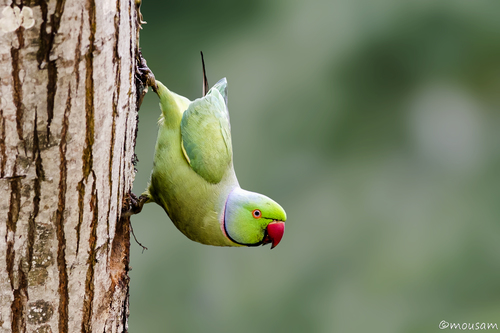
Rose-ringed Parakeet
The Rose-ringed Parakeet (*Psittacula krameri*) is a vibrant and adaptable bird species known for its striking green plumage and characteristic red ring around the neck (in males). Originally native to sub-Saharan Africa and South Asia, it has established feral populations in numerous cities worldwide, making it one of the most widespread parrot species. Its success is due to its generalist diet, ability to adapt to various habitats, and high reproductive rate. Ecologically, it plays a role in seed dispersal but can also be an agricultural pest in some regions. In some cultures, it's a popular pet, while in others, it's considered an invasive species.
37-43 cm
Length
42-48 cm
Wingspan
Least Concern
Conservation Status
Distribution
Native to sub-Saharan Africa (from Senegal to Sudan) and South Asia (India, Pakistan, Nepal, Bangladesh, Sri Lanka). Established feral populations exist in Europe (particularly the UK, Netherlands, Belgium, Germany, Spain, Italy), North America (Florida, California), the Middle East, Japan, and various islands worldwide. They exhibit no significant altitudinal range limitations, found from sea level to moderate elevations.
Lifespan
Typically 20-30 years in captivity; wild lifespan is less well-documented but likely shorter.
Rose-ringed Parakeet's Habitat
Habitat Types
Woodlands, Savannas, Agricultural lands, Urban parks, Gardens, Mangrove forests (in some regions)
Climate Zones
Tropical, Subtropical, Temperate
Adaptations
Highly adaptable to various food sources and nesting sites. Tolerant of human presence and disturbance. Can withstand a wide range of temperatures.
Variations
Four recognized subspecies exist: *P. k. krameri* (African Rose-ringed Parakeet), *P. k. parvirostris* (Abyssinian Rose-ringed Parakeet), *P. k. borealis* (Northern Rose-ringed Parakeet), and *P. k. manillensis* (Indian Rose-ringed Parakeet). These differ slightly in size and coloration.
Appearance
Breeding Plumage
Minimal difference. Adult males have a distinctive black and rose-pink ring around their necks, which is absent or faint in females and juveniles.
Seasonal Feather Changes
None
Sex Based Plumage Differences
Males possess the neck ring; females and juveniles do not. Females may have a slightly duller green coloration overall.
Notable Features
Bright green plumage, Long, pointed tail, Red, hooked beak, Black and rose-pink neck ring (in adult males)
Diet and Feeding
Primary Foods
Seeds, Fruits, Nuts, Berries, Blossoms, Agricultural crops (e.g., grains, fruits)
Foraging Behavior
Forages in flocks, often in trees and on the ground. Uses its strong beak to crack open seeds and nuts. Can be quite acrobatic while feeding.
Specializations
Strong beak adapted for cracking hard seeds and nuts. Dexterous feet used to hold food items.
Seasonal Diet Variations
Diet varies depending on the availability of food sources. May consume more fruits during fruiting seasons and more seeds during other times.
Behavior
Social Structure
Highly social, often forming large flocks outside of the breeding season. Breeding pairs are territorial.
Communication
Loud, screeching calls, Chattering, Whistles, Visual displays (e.g., head bobbing, wing flicking)
Migration
Generally non-migratory, but some populations may undertake local movements in response to food availability.
Territorial or Group Behaviors
Breeding pairs defend their nesting territory. Outside of the breeding season, they form large, noisy flocks that roost and forage together.
Conservation
Threats
Habitat loss (in some native regions), Persecution as agricultural pests, Trapping for the pet trade (although now less common due to regulations)
Protection Programs
CITES Appendix II (regulates international trade), Some local laws protecting native populations or managing feral populations
Local National Laws
Varies widely. In some countries, it's protected; in others, it's considered an agricultural pest and may be controlled.
Population Trend
Increasing
Population Estimates
Global population is very large and increasing, estimated to be in the millions.
Interesting Facts
They are one of the few parrot species that have successfully established feral populations outside their native range.
This demonstrates their adaptability and resilience.
Feral populations in Europe are thought to have originated from escaped or released pet birds.
This highlights the impact of the pet trade on wild populations.
They can mimic human speech and other sounds.
This is a common trait among parrots and contributes to their popularity as pets.
Their scientific name, 'krameri,' honors Austrian naturalist Wilhelm Heinrich Kramer.
Named in recognition of his contributions to ornithology.
Faqs about Rose-ringed Parakeet
Are Rose-ringed Parakeets good pets?
They can be, but they require a lot of attention, training, and a large cage. They are also very noisy and can be destructive if not properly stimulated. Consult with an avian veterinarian or experienced bird owner before acquiring one.
Are they invasive?
In many areas outside their native range, they are considered invasive. They can compete with native birds for nesting sites and food resources, and they can damage crops.
What do I do if I see a Rose-ringed Parakeet in the wild?
If you are in their native range, observe and enjoy! If you are outside their native range, it's likely a feral bird. You can report sightings to local wildlife organizations.
How can you tell the difference between a male and a female?
Adult males have a distinctive black and rose-pink ring around their necks, which is absent or faint in females.
Copyright @ Nature Style Limited. All Rights Reserved.
 English
English